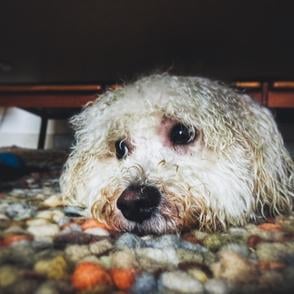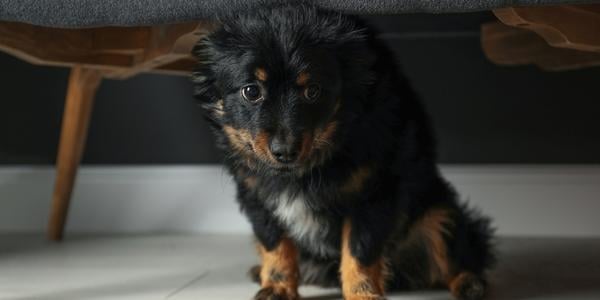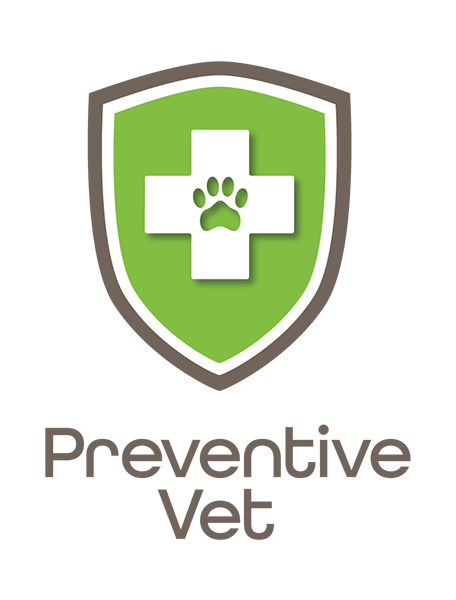If certain sounds send your dog into a panic, they may suffer from noise anxiety. While a common condition in dogs, noise anxiety or phobias can greatly affect their health and quality of life. To ease your dog's anxiety and stress, you can help your dog with veterinary support and at-home treatment. With patience, consistency, and the right treatment plan, most dogs can overcome their noise anxiety and lead happier, more comfortable lives.
Quick Links

There is no single definite cause of noise anxiety in dogs. It can be a result of a variety of factors. These include:
Our mission is to help save dogs' and cats’ lives through our educational content. To support our efforts, this page may contain affiliate links. We earn a commission for qualifying purchases – at no cost to you.
Noise anxiety (noise aversion) in dogs is a condition where a dog experiences fear or stress in response to certain sounds or noises. This anxiety can be triggered by a variety of sounds, including thunder, fireworks, sirens, gunshots, construction noise, and even household items such as vacuum cleaners, blenders, or fire alarms.
Noise anxiety and thunderstorm phobia in dogs are related conditions, but there is a difference between them. While noise anxiety includes a variety of sounds, thunderstorm phobia is a specific form of noise anxiety that is triggered by thunderstorms. Dogs with thunderstorm phobia may notice the change in air pressure before storms, triggering anxiety symptoms prior to even hearing the sounds of thunder. While thunderstorm phobia is a form of noise anxiety, not all dogs with noise anxiety have a specific phobia of thunderstorms.
According to one study, over 67% of dogs suffer from at least one form of noise aversion. And although noise anxiety symptoms may not seem dire to some, they can contribute to serious medical and behavioral issues over time. If your dog's noise anxiety goes untreated, it may lead to or exacerbate other anxieties, such as canine separation anxiety.
When a dog with noise anxiety is exposed to triggering events such as fireworks or other loud noises, they may experience similar feelings to those of a person who is having a panic attack. In extreme cases, a dog may even injure themselves in their effort to escape the perceived threat.
These anxiety symptoms are driven by the activation of a dog's sympathetic nervous system, also known as the "fight or flight" system. This system goes into overdrive when a pet is frightened or feels as though they are under attack. Unfortunately, unlike people, a dog cannot differentiate a firework or car backfiring from an actual threat, which is why these types of behaviors can be confusing to people.
The most common symptoms of noise anxiety in dogs include:
The first step in helping your dog overcome noise anxiety is to speak with your veterinarian. They can rule out any underlying medical conditions and help determine the severity of the anxiety.
Your veterinarian will next decide what is the best first step for your pet and their specific noise phobia. They may suggest particular supplements or medication options, which can be very helpful in boosting the effectiveness of behavior modification treatment for noise anxiety.
Always speak with your veterinarian before starting your dog on a new supplement. Some supplement ingredients can interact with prescription medications.
For moderate to severe cases, there are particular anxiety medications made for noise anxiety specifically. Your veterinarian can explain the options and help you decide whether to explore short-acting medication (for event-specific noise anxiety, such as firework or thunderstorm events) or long-acting medication (for ongoing noise anxiety).
To reduce your dog's anxiety and bolster at-home treatment, it's important to prevent your dog from experiencing anxiety as much as possible. You can do this by setting up your dog's home environment (or other environments where they exhibit noise anxiety) in a way to reduce triggering sounds and encourage relaxation.
Provide a safe and comfortable space for your dog to retreat to before a noise event occurs or when they are feeling anxious. This could be a crate (only if your dog is already happily crate-trained), a room with soft bedding, or a quiet corner of the house. For dogs with noise anxiety, their safe space should ideally be away from windows or outside walls so that outside noise is less intrusive.
Double-check your dog's safe space to ensure it's free and clear of any safety hazards or items that could be harmful to your dog, like toxic plants, power cords, or other hazards.
Learn more about setting up a safe space for your dog.
Mask outside noise for your dog, whether specifically in their safe space or in your home while you're gone. The most effective way to mask sound is to use a box fan pointed in the direction where the sound is coming from (such as a specific window or door). The fan not only provides some white noise to lessen the outside sound, but the airflow also disrupts sound waves.
Other noise masking options include white noise machines or turning on the radio or television. If you leave music on for your dog, certain genres have been shown to reduce stress for dogs: classical, reggae, and soft rock.
Find out more about using music to calm an anxious dog.
More ways to encourage relaxation include plugging in or lightly spritzing your dog's bed with calming dog pheromones or having your dog wear an anxiety wrap or shirt. Provide your dog with decompression activities, such as a licking mat, a frozen stuffed food toy, a snuffle mat, or an edible chew to gnaw on.
Read more about how to calm down an anxious dog.

Behavior modification for noise anxiety in dogs relies on desensitization and counterconditioning techniques. This means your dog becomes less fearful of loud noises over time through controlled low-level exposure and creating positive associations.
Desensitization focuses on systematic and low-level exposure to help a dog get used to sounds. Ideally, desensitization creates a neutral response to noise from your dog rather than fear or stress.
Start with low-volume sounds. Begin with playing the sound at a low volume that does not trigger your dog's anxiety.
Pair sounds with positive experiences. Play the sounds during your dog's regular positive experiences during the day, such as mealtime, during playtime, or when cuddling with you, to create positive associations with the sounds.
Gradually increase exposure time. As you practice, and as long as your dog is not exhibiting signs of anxiety, increase the amount of time that your dog is exposed to the sound. Start with short exposures, such as a few seconds, and slowly increase the time over several weeks.
Increase volume slowly. As your dog becomes more comfortable with the sounds, gradually increase the volume. Be patient and go at your dog's pace.
Reward calm behavior. Reinforce your dog for calm or positive behaviors during sound exposure sessions with praise, play, treats, or whatever your dog finds rewarding.
Practice regularly and in different locations. Practice sound desensitization regularly to help reinforce positive associations with the sounds and help your dog become more comfortable and less anxious. Start introducing the sounds in different environments, such as inside and outside your home, to help your dog become accustomed to them in different situations. Having the Pupstanding App on your phone makes this easy.
When using desensitization, it's crucial to go at your dog's pace. Do not rush through this process, as increasing the volume too quickly can cause "sensitization" – the opposite of what you want. If your dog exhibits signs of increasing stress or anxiety during the desensitization process, immediately stop the sound recording.
Counterconditioning goes one step further than desensitization because it is specifically targeting the negative emotional response your dog has to sounds and works to change it to a positive response through association-building. For a dog with noise anxiety, the sound triggers a panic response. But with practice, the sound instead triggers a positive anticipatory response (like looking to you for a treat) because it now predicts something good.
Make a list of triggering noises. Identify the specific sounds that trigger your dog's anxiety, such as thunder, fireworks, or loud vehicles.
BOOM = Cookie! Creating a positive association. Pair the triggering sound with a "treat jackpot!"
Example 1: If there is a peal of thunder, immediately throw a treat scatter on the ground, and praise your dog.
Example 2: Firework goes boom, toss your dog a cookie and praise.
Example 3: While on a walk, a loud truck drives by. Immediately start giving your dog high-value treats, and don't stop giving treats until the truck is out of earshot.
(These Bark Pouch on-the-go treats are perfect for walks because they make it easy to treat continuously while the sound is happening.)
Be consistent. Consistency is key when counterconditioning your dog. You want your dog to anticipate a treat party whenever they hear the triggering sound. This is why it's so important to be prepared with easily-accessible treats.
You can use sound recordings to allow for planned counterconditioning sessions with your dog. Similar to desensitization, start with a very low volume and keep the training sessions short. Toss the first treat right after the sound starts and continue throughout the recording, especially if your dog shows alert behaviors to the sound, such as ears pricked forward, turning towards the speaker, or a soft bark. If your dog exhibits signs of increasing stress or anxiety, immediately stop the sound recording and end the session.
In severe cases of noise anxiety, multiple anxieties, or if your dog exhibits aggressive or self-harm behavior during anxiety episodes, getting professional support from a veterinary behaviorist or certified canine behavior consultant is extremely beneficial.
Every dog is different, and the treatment approach for their particular noise anxiety may need to be tailored to their individual needs and experiences.
With patience, consistency, and the right treatment plan, most dogs can overcome their noise anxiety and lead happier, more comfortable lives.
The duration of treatment for noise anxiety can vary depending on the individual dog, anxiety triggers, and the severity of their case. Some dogs may respond well to treatment and show improvement within a few weeks, while others may require several months of treatment before significant improvement is seen.
The length of treatment may also vary depending on the specific method being used. For example, desensitization and counterconditioning may require several sessions over a period of weeks or months to be effective. Medications may take several weeks to take effect, and the duration of medication use may vary depending on the dog's response to treatment and the type of noise anxiety. Talk to your veterinarian about how anti-anxiety medications may help speed up the treatment process.
It's important to work closely with a veterinarian or professional dog trainer to develop a treatment plan that is tailored to your dog's individual needs and to monitor your dog's progress throughout the treatment process. With patience, consistency, and the right treatment approach, many dogs with noise anxiety can show significant improvement over time.
Punishing a dog who is experiencing noise anxiety is only going to reinforce the anxiety — always avoid yelling at or other punishment when your dog is acting anxious. This requires patience on your part, as some anxiety symptoms, like barking or potty accidents, can be frustrating. Remember, your dog is not trying to give you a hard time, they are having a hard time and need your support.
Inconsistent training or lack of management can make noise anxiety worse in dogs. Noise anxiety is not something that just goes away; if left unaddressed, it often increases in severity over time. If a dog is constantly subjected to a sound or noise experience that causes panic, they become more sensitized to it, and their symptoms get worse. Do not give up on desensitization and counterconditioning. If you reach a point where it feels like you're not making progress, it's best to talk to your veterinarian or a certified behavior consultant about how best to proceed.
The Pet InfoRx® is made possible, in part, through our partnership with AlignCare®.


© Preventive Vet. All rights reserved. PreventiveVet.com
